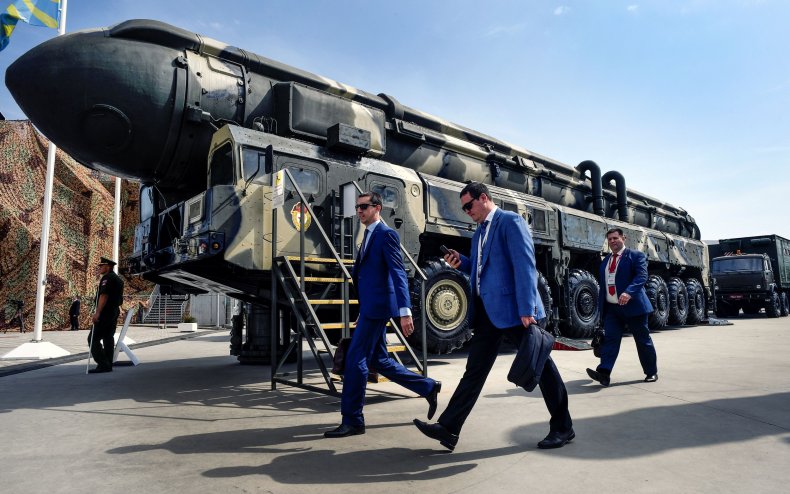Russia’s Nuclear ‘Satan 2’ Missile Compared to U.S. Minuteman
Russia’s “Satan 2” intercontinental ballistic missile (ICBM) is said by its manufacturer to be unparalleled worldwide, though experts believe the threat of its use might exceed the power of the weapon.
Russian President Vladimir Putin issued a stern warning to the West this week, implying he would use his weapons if persuaded by “nuclear blackmail.” He put the onus of military escalation on NATO‘s high-ranking representatives, who in Putin’s eyes have increased the potential of using “weapons of mass destruction—nuclear weapons—against Russia.”
It has renewed focus on the RS-28 Sarmat ICBM, code-named “Satan 2” by NATO. Vladimir Degtyar, CEO of the JSC Makeyev Design Bureau, which made the “Satan 2,” told Russian state-owned news agency Tass it “has no equals in the world.”
Degtyar told Tass that the missile “will leave its silo under any conditions and fulfill its task with 100 percent certainty.”

ALEXANDER NEMENOV/AFP via Getty Images
The new missile replaces the R-36 Voevoda, code-named “Satan” by NATO.
Russia completed a missile test of the “Satan 2” on April 20, about three years after its capabilities were introduced by Putin.
The Pentagon said following the “Satan 2” test that Russia “properly notified” the U.S. under its New START treaty obligations.
“Such testing is routine and was not a surprise,” Pentagon Press Secretary John Kirby said April 20. “We did not deem the test to be a threat to the United States or its allies. The Department remains focused on Russia’s unlawful and unprovoked aggression against Ukraine.”
After awarding production contracts to Makeyev Design Bureau and NPOMash in early 2011, Russia reportedly completed its first prototype of the missile in late 2015. In December of 2017, technical difficulties resulted from the first silo ejection test.
The missile is 116 feet long and weighs 220 tons. The Center for Strategic and International Studies reported that its development began in the early 2000s. It can reportedly carry up to 15 light nuclear warheads as part of an MIRV (Multiple Independently Targetable Re-Entry Vehicles).
MIRVs were developed in the early 1960s to help missiles deliver multiple nuclear warheads to different targets.
“In contrast to a traditional missile, which carries one warhead, MIRVs can carry multiple warheads,” the Center for Strategic and International Studies reported. “For instance, a Russian MIRVed missile under development may be able to carry up to 16 warheads, each in a separate re-entry vehicle.”
The warheads are also reportedly able to be released from the missile at different speeds and in different directions, as some can hit targets as far as 932 miles (1,500 kilometers).
The Center for Strategic and International Studies reported that the “Satan 2” has an estimated range between 6,200 and 11,180 miles (10,000 to 18,000 kilometers).
By comparison, the U.S. LGM-30 Minuteman missile weighs about 79,400 pounds and has a 5.5-foot diameter, about 4 feet smaller than the Satan 2. The Minuteman can travel about 8,100 miles (13,000 kilometers).
A U.S. Air Force spokesperson told Newsweek that the current ICBM force consists of 400 Minuteman III missiles at the 90th Missile Wing at F.E. Warren AFB, Wyoming; the 341st Missile Wing at Malmstrom Air Force Base, Montana; and the 91st Missile Wing at Minot Air Force Base, North Dakota.
The active-force inventory is 400, with no missiles available for reserves or the Air National Guard.
John Erath, senior policy director for the Center for Arms Control and Non-Proliferation, told The Washington Post following Russia’s test launch that Putin’s threats are more worrisome than the weapon itself.
“We should be very concerned about this practice of making threats as an instrument of Russian policy [that] is gaining currency,” Erath said.
Experts argue in Defense News, however, that “ICBMs represent a vital component of America’s nuclear deterrent” and that the U.S. must modernize to keep up with Russia and China, the latter of which has the Dongfeng ICBM.
“Those characteristics of a modernized ICBM leg of the nuclear triad help deter adversaries from launching a nuclear attack in the first place, preventing nuclear war and making Americans safer,” experts said regarding the ICBM’s ability to be responsive and provide a “hedge” in anti-submarine warfare.

Comments are closed.